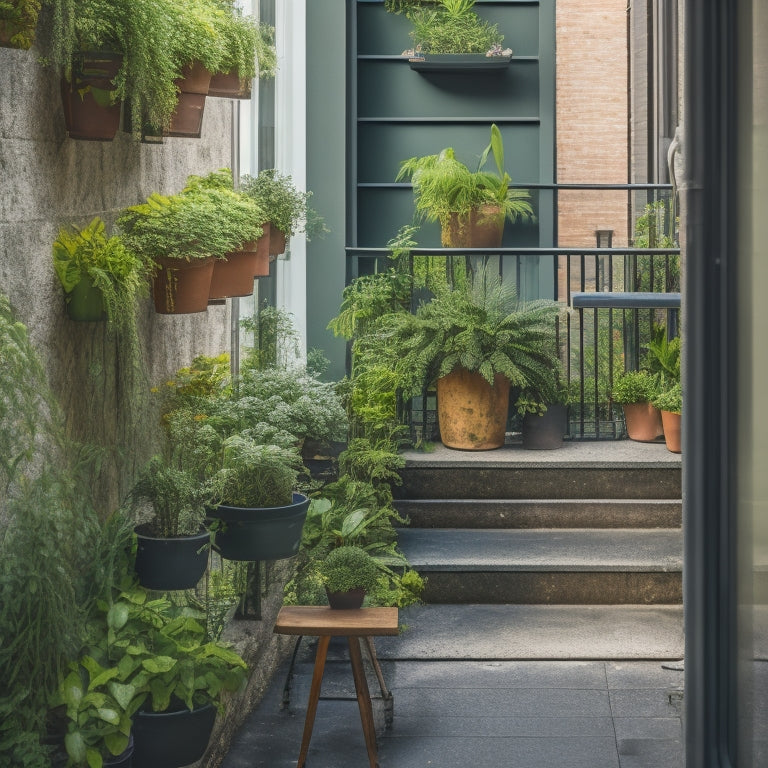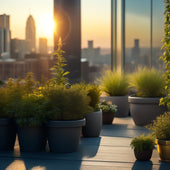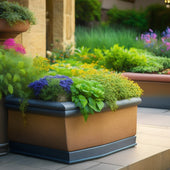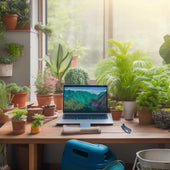
Why Small Spaces Need DIY Vertical Gardens
Share
You're likely no stranger to the challenges of urban gardening, but that doesn't mean you have to sacrifice your green thumb. Limited space is no match for the creativity of DIY vertical gardens, which can triple or quadruple your plant capacity and elevate your living space - literally. By harnessing every inch of wall space, you'll not only maximize your space but also create a lush, vibrant environment that's perfect for urban dwellers. With a little know-how, you can transform even the smallest of spaces into a thriving oasis, and discover the many benefits that come with bringing nature to the city.
Key Takeaways
• DIY vertical gardens maximize space in small areas, utilizing walls and trellises to grow plants, and can triple or quadruple plant capacity.
• They reduce floor clutter, creating a sense of openness and contributing to a more relaxed living environment with functional layouts.
• Vertical gardens offer a creative outlet for personal expression, allowing individuals to tailor gardening solutions to their unique spaces and styles.
• They provide numerous benefits, including improved air quality, increased biodiversity, and opportunities for community engagement in green initiatives.
• DIY vertical gardens promote sustainable practices, conserve water, and minimize waste, making them an ideal solution for eco-conscious urban dwellers.
Urban Gardening Challenges Abound
As you venture into urban gardening, you'll quickly discover that limited space, poor soil quality, and inadequate light are just a few of the obstacles that can stand between you and a thriving garden.
Don't let these challenges discourage you, though! With a little creativity and planning, you can overcome them and still enjoy a bountiful harvest.
One solution is to explore container gardening, where you can grow plants in pots or planters on balconies, patios, or rooftops.
This approach allows you to control the soil quality and light exposure, giving your plants the best chance to thrive.
Rooftop gardens, in particular, offer a unique opportunity to create a lush oasis amidst the concrete jungle.
No Space, No Problem, Right?
You're probably thinking that you can't create a thriving garden because you don't have a sprawling backyard.
But the truth is, you can still grow your favorite plants and herbs even with limited space.
Maximizing Limited Areas
Limited outdoor space doesn't have to limit your gardening ambitions, since cleverly designed vertical gardens can thrive even in the tiniest of spots. You can still enjoy the benefits of gardening, even with a small balcony, patio, or backyard.
By using container gardening, you can make the most of your available space. Choose containers that are narrow and tall to maximize your space, and select plants that are compact or trailing to add visual interest. Consider using space-saving techniques like tiered planters or hanging baskets to create a lush, layered look.
Don't be afraid to get creative and think outside the box (or container!). You can also repurpose items like wooden crates, trellises, or even old pallets to create unique and functional planters.
With a little imagination and planning, you can turn even the smallest space into a thriving oasis. So, don't let limited space hold you back – start planning your vertical garden today!
Efficient Use of Walls
By utilizing walls, you can access a wealth of hidden space for your vertical garden, even in the most compact of areas. This efficient use of walls allows you to create a lush oasis without sacrificing precious floor space.
Wall-mounted planters are a great way to get started, providing a sleek and modern way to display your plants. These planters come in a variety of sizes and materials, making it easy to find one that fits your style and space.
Another option is to use vertical trellises, which can be attached directly to the wall or placed in a corner. These trellises provide support for climbing plants, allowing them to grow upwards and outwards, making the most of your wall space.
Maximizing Space With Verticals
As you start planning your DIY vertical garden, you're likely thinking about how to make the most of your available space.
By using verticals, you'll be able to optimize your wall space, increasing the number of plants you can grow while reducing clutter on the floor.
Optimize Wall Space
You'll find that incorporating vertical gardens into your space allows you to cleverly utilize every inch of available wall space, making the most of your room's dimensions. This is especially important in small spaces where every inch counts. By optimizing your wall space, you can create a sense of openness and airiness, making your room feel larger than it actually is.
When selecting plants for your vertical garden, consider varieties that are compact, trailing, or vining. These plants will thrive in a vertical setting and add visual interest to your wall art.
Speaking of wall art, a vertical garden can also serve as a beautiful piece of living art, adding a touch of greenery to your space. Choose plants with varying textures, colors, and shapes to create a visually appealing display.
Increase Plant Capacity
With vertical gardens, every square inch of wall space can be converted into a thriving plant haven, allowing you to triple or even quadruple your plant capacity. This means you can grow more plants in a smaller area, making the most of your space.
By selecting plants that thrive in vertical environments, such as trailing vines or compact varieties, you can maximize your plant capacity. Consider using growth strategies like layering, where you plant smaller plants in front of larger ones, or using a trellis system to train vines to grow upwards. These techniques will help you make the most of your vertical space and increase your plant capacity.
Additionally, you can experiment with different plant selection, such as mixing flowers, herbs, and vegetables, to create a diverse and thriving ecosystem. By implementing these strategies, you'll be able to grow a lush and vibrant garden, even in the smallest of spaces.
Reduce Floor Clutter
By going vertical, you're not only increasing plant capacity but also freeing up valuable floor space, allowing you to breathe easier and move more freely around your home or office. This is especially essential in small spaces where every square foot counts.
When plants are scattered around the floor, they can create clutter and make your space feel cramped. By elevating them, you're creating a sense of openness and airiness.
Vertical gardens are an excellent clutter solution, keeping your floors clear of pots and planters. This, in turn, makes floor organization a breeze.
You can easily sweep, mop, or vacuum without having to navigate around obstacles. Plus, with a clear floor, you can create a more functional and efficient layout for your furniture and decor.
This means you can finally fit in that reading nook or home office you've been dreaming of. By incorporating DIY vertical gardens into your space, you'll be amazed at how much more relaxed and organized you'll feel.
The Power of DIY Gardening
Taking control of your gardening experience can be a liberating and empowering feeling, as it allows you to tailor your space to your unique needs and preferences. By embracing DIY gardening, you're not only saving money but also adopting sustainable practices that benefit the environment. You'll have the freedom to experiment with creative solutions that cater to your specific climate, soil type, and available space.
As you immerse yourself in the world of DIY gardening, you'll discover the joy of nurturing your plants from seed to harvest. You'll develop a deeper connection with nature and a sense of accomplishment as you watch your hard work flourish. With every new project, you'll refine your skills and gain confidence in your ability to problem-solve and adapt.
Transforming Small Spaces Into Oases
You can transform even the smallest of spaces into thriving oases by leveraging the power of vertical gardening, where every inch counts and creativity knows no bounds. By using walls, trellises, or other supports, you can create a stunning display of greenery that not only purifies the air but also elevates your space aesthetics. The key is to choose a diverse plant variety that thrives in small spaces, such as leafy greens, herbs, or flowering plants.
Consider the lighting conditions in your space and select plants that fit those requirements. For instance, if your space receives limited natural light, opt for low-light plants like Chinese Evergreen or Pothos. If you have a sunny spot, go for plants like Basil or Cherry Tomatoes.
Don't be afraid to mix and match different textures, colors, and shapes to create a visually appealing arrangement. With a little creativity and experimentation, you can turn even the most compact areas into a serene oasis that brings you joy and tranquility.
Bringing Nature to the City
As city dwellers, surround yourself with the sights, sounds, and scents of nature by incorporating DIY vertical gardens into your urban landscape.
You'll be contributing to the city's biodiversity, which is essential for maintaining a healthy ecosystem. By bringing greenery into the city, you'll help purify the air, reduce noise pollution, and provide habitats for urban wildlife.
Furthermore, DIY vertical gardens promote urban sustainability by reducing the urban heat island effect, conserving water, and minimizing waste.
When you create your own DIY vertical garden, you'll not only enhance your living space but also become an active participant in sustainable urban development.
Imagine strolling through your city's concrete jungle, surrounded by lush green walls and vibrant flowers. It's a rejuvenating escape from the hustle and bustle of urban life.
By embracing DIY vertical gardens, you'll be part of a movement that's redefining the urban landscape, one garden at a time.
Frequently Asked Questions
Can Vertical Gardens Thrive in Low-Light Indoor Spaces?
"Like a whisper in the dark, your doubts about low-light vertical gardens are silenced: yes, they can thrive! You'll just need to choose plants with low light requirements, like Chinese Evergreen or Pothos, and provide the right care for a lush, vibrant display."
How Often Should I Water My DIY Vertical Garden?
When determining your DIY vertical garden's watering schedule, you'll want to check the soil moisture daily, watering only when it feels dry to the touch, avoiding overwatering, which can lead to root rot and other issues.
What Types of Plants Are Best Suited for Vertical Gardens?
You'll thrive with a mix of herb varieties like basil, mint, and rosemary, alongside decorative plants like ferns, ivy, and flowering vines, which will not only purify the air but also add visual appeal to your space.
Can I Use a Trellis to Create a DIY Vertical Garden?
You can definitely use a trellis to create a DIY vertical garden, choosing from various trellis types, such as wall-mounted or freestanding, to complement your vertical design and maximize space.
Are DIY Vertical Gardens Difficult to Maintain and Clean?
"You'll be relieved to know that 75% of DIY vertical gardeners report low maintenance needs! To keep yours thriving, follow simple maintenance tips like pruning and fertilizing, and use gentle cleaning solutions to wipe down planters and trellises."
Related Posts
-

Why Choose Cinder for Your Rooftop Garden Planters
You choose cinder for your rooftop garden planters because they offer a unique combination of durability, versatility...
-

Why Choose Cinder for Your Rooftop Garden Planters
You choose cinder for your rooftop garden planters because they offer a unique combination of durability, versatility...
-

Why Choose Cinder for Your Rooftop Garden Planters
You choose cinder for your rooftop garden planters because they offer a unique combination of durability, versatility...
-

Why Choose Cinder for Your Rooftop Garden Planters
You choose cinder for your rooftop garden planters because they offer a unique combination of durability, versatility...
-

Why Choose Cinder for Your Rooftop Garden Planters
You choose cinder for your rooftop garden planters because they offer a unique combination of durability, versatility...
-

Why Choose Cinder for Your Rooftop Garden Planters
You choose cinder for your rooftop garden planters because they offer a unique combination of durability, versatility...
-

Why Choose Cinder for Your Rooftop Garden Planters
You choose cinder for your rooftop garden planters because they offer a unique combination of durability, versatility...
-

Why Choose Cinder for Your Rooftop Garden Planters
You choose cinder for your rooftop garden planters because they offer a unique combination of durability, versatility...
-

Why Choose Cinder for Your Rooftop Garden Planters
You choose cinder for your rooftop garden planters because they offer a unique combination of durability, versatility...
-

Why Choose Cinder for Your Rooftop Garden Planters
You choose cinder for your rooftop garden planters because they offer a unique combination of durability, versatility...
-

Why Choose Cinder for Your Rooftop Garden Planters
You choose cinder for your rooftop garden planters because they offer a unique combination of durability, versatility...
-

Why Choose Cinder for Your Rooftop Garden Planters
You choose cinder for your rooftop garden planters because they offer a unique combination of durability, versatility...
-

Why Choose Cinder for Your Rooftop Garden Planters
You choose cinder for your rooftop garden planters because they offer a unique combination of durability, versatility...
-

Why Choose Cinder for Your Rooftop Garden Planters
You choose cinder for your rooftop garden planters because they offer a unique combination of durability, versatility...
-

Why Choose Cinder for Your Rooftop Garden Planters
You choose cinder for your rooftop garden planters because they offer a unique combination of durability, versatility...
-

Why Choose Cinder for Your Rooftop Garden Planters
You choose cinder for your rooftop garden planters because they offer a unique combination of durability, versatility...
-

Why Choose Cinder for Your Rooftop Garden Planters
You choose cinder for your rooftop garden planters because they offer a unique combination of durability, versatility...
-

Why Choose Cinder for Your Rooftop Garden Planters
You choose cinder for your rooftop garden planters because they offer a unique combination of durability, versatility...
-

Why Choose Cinder for Your Rooftop Garden Planters
You choose cinder for your rooftop garden planters because they offer a unique combination of durability, versatility...
-

Why Choose Cinder for Your Rooftop Garden Planters
You choose cinder for your rooftop garden planters because they offer a unique combination of durability, versatility...
-

Why Choose Cinder for Your Rooftop Garden Planters
You choose cinder for your rooftop garden planters because they offer a unique combination of durability, versatility...
-

Why Choose Cinder for Your Rooftop Garden Planters
You choose cinder for your rooftop garden planters because they offer a unique combination of durability, versatility...
-

Why Choose Cinder for Your Rooftop Garden Planters
You choose cinder for your rooftop garden planters because they offer a unique combination of durability, versatility...
-

Why Choose Cinder for Your Rooftop Garden Planters
You choose cinder for your rooftop garden planters because they offer a unique combination of durability, versatility...
-

Why Choose Cinder for Your Rooftop Garden Planters
You choose cinder for your rooftop garden planters because they offer a unique combination of durability, versatility...
-

Why Choose Cinder for Your Rooftop Garden Planters
You choose cinder for your rooftop garden planters because they offer a unique combination of durability, versatility...
-

Why Choose Cinder for Your Rooftop Garden Planters
You choose cinder for your rooftop garden planters because they offer a unique combination of durability, versatility...
-

Why Choose Cinder for Your Rooftop Garden Planters
You choose cinder for your rooftop garden planters because they offer a unique combination of durability, versatility...
-

5 Essential Drainage Tips for Block Planters
When using block planters, you'll want to guarantee effective drainage to prevent waterlogging and root rot. Start by...
-

5 Essential Drainage Tips for Block Planters
When using block planters, you'll want to guarantee effective drainage to prevent waterlogging and root rot. Start by...
-

5 Essential Drainage Tips for Block Planters
When using block planters, you'll want to guarantee effective drainage to prevent waterlogging and root rot. Start by...
-

5 Essential Drainage Tips for Block Planters
When using block planters, you'll want to guarantee effective drainage to prevent waterlogging and root rot. Start by...
-

5 Essential Drainage Tips for Block Planters
When using block planters, you'll want to guarantee effective drainage to prevent waterlogging and root rot. Start by...
-

5 Essential Drainage Tips for Block Planters
When using block planters, you'll want to guarantee effective drainage to prevent waterlogging and root rot. Start by...
-

5 Essential Drainage Tips for Block Planters
When using block planters, you'll want to guarantee effective drainage to prevent waterlogging and root rot. Start by...
-

5 Essential Drainage Tips for Block Planters
When using block planters, you'll want to guarantee effective drainage to prevent waterlogging and root rot. Start by...
-

5 Essential Drainage Tips for Block Planters
When using block planters, you'll want to guarantee effective drainage to prevent waterlogging and root rot. Start by...
-

5 Essential Drainage Tips for Block Planters
When using block planters, you'll want to guarantee effective drainage to prevent waterlogging and root rot. Start by...
-

5 Essential Drainage Tips for Block Planters
When using block planters, you'll want to guarantee effective drainage to prevent waterlogging and root rot. Start by...
-

5 Essential Drainage Tips for Block Planters
When using block planters, you'll want to guarantee effective drainage to prevent waterlogging and root rot. Start by...
-

5 Essential Drainage Tips for Block Planters
When using block planters, you'll want to guarantee effective drainage to prevent waterlogging and root rot. Start by...
-

5 Essential Drainage Tips for Block Planters
When using block planters, you'll want to guarantee effective drainage to prevent waterlogging and root rot. Start by...
-

5 Essential Drainage Tips for Block Planters
When using block planters, you'll want to guarantee effective drainage to prevent waterlogging and root rot. Start by...
-

5 Essential Drainage Tips for Block Planters
When using block planters, you'll want to guarantee effective drainage to prevent waterlogging and root rot. Start by...
-

5 Essential Drainage Tips for Block Planters
When using block planters, you'll want to guarantee effective drainage to prevent waterlogging and root rot. Start by...
-

5 Essential Drainage Tips for Block Planters
When using block planters, you'll want to guarantee effective drainage to prevent waterlogging and root rot. Start by...
-

Must-Have Tools for Building Block Planters Online
When building block planters online, you'll need essential tools to guarantee a sturdy and visually appealing structu...
-

Must-Have Tools for Building Block Planters Online
When building block planters online, you'll need essential tools to guarantee a sturdy and visually appealing structu...
-

Must-Have Tools for Building Block Planters Online
When building block planters online, you'll need essential tools to guarantee a sturdy and visually appealing structu...
-

Must-Have Tools for Building Block Planters Online
When building block planters online, you'll need essential tools to guarantee a sturdy and visually appealing structu...
-

Must-Have Tools for Building Block Planters Online
When building block planters online, you'll need essential tools to guarantee a sturdy and visually appealing structu...
-

Must-Have Tools for Building Block Planters Online
When building block planters online, you'll need essential tools to guarantee a sturdy and visually appealing structu...
-

Must-Have Tools for Building Block Planters Online
When building block planters online, you'll need essential tools to guarantee a sturdy and visually appealing structu...
-

Must-Have Tools for Building Block Planters Online
When building block planters online, you'll need essential tools to guarantee a sturdy and visually appealing structu...
-

Must-Have Tools for Building Block Planters Online
When building block planters online, you'll need essential tools to guarantee a sturdy and visually appealing structu...
-

Must-Have Tools for Building Block Planters Online
When building block planters online, you'll need essential tools to guarantee a sturdy and visually appealing structu...
-

Must-Have Tools for Building Block Planters Online
When building block planters online, you'll need essential tools to guarantee a sturdy and visually appealing structu...
-

Must-Have Tools for Building Block Planters Online
When building block planters online, you'll need essential tools to guarantee a sturdy and visually appealing structu...
-

Must-Have Tools for Building Block Planters Online
When building block planters online, you'll need essential tools to guarantee a sturdy and visually appealing structu...
-

Must-Have Tools for Building Block Planters Online
When building block planters online, you'll need essential tools to guarantee a sturdy and visually appealing structu...
-

Must-Have Tools for Building Block Planters Online
When building block planters online, you'll need essential tools to guarantee a sturdy and visually appealing structu...
-

Must-Have Tools for Building Block Planters Online
When building block planters online, you'll need essential tools to guarantee a sturdy and visually appealing structu...
-

Must-Have Tools for Building Block Planters Online
When building block planters online, you'll need essential tools to guarantee a sturdy and visually appealing structu...
-

Must-Have Tools for Building Block Planters Online
When building block planters online, you'll need essential tools to guarantee a sturdy and visually appealing structu...
-

Must-Have Tools for Building Block Planters Online
When building block planters online, you'll need essential tools to guarantee a sturdy and visually appealing structu...
-

Must-Have Tools for Building Block Planters Online
When building block planters online, you'll need essential tools to guarantee a sturdy and visually appealing structu...
-

Must-Have Tools for Building Block Planters Online
When building block planters online, you'll need essential tools to guarantee a sturdy and visually appealing structu...
-

Must-Have Tools for Building Block Planters Online
When building block planters online, you'll need essential tools to guarantee a sturdy and visually appealing structu...
-

Must-Have Tools for Building Block Planters Online
When building block planters online, you'll need essential tools to guarantee a sturdy and visually appealing structu...


